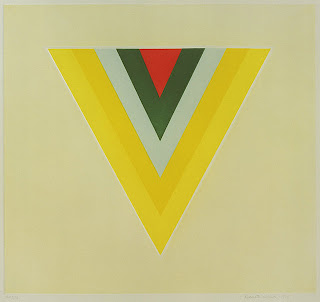Washington Color School

When I saw firstly this April painted by Kenneth Noland I thought at the Targets of Jasper Jones, only Noland is different, with his delicacy of the blue. While Jones is in search for the place of the objects becoming images and symbols and loosing their concrete reality, Noland is rather preoccupied with understanding the place of the spaces within the universe: spaces of light blue and dark blue, and green, and yellow, spaces fighting with other spaces, each one trying to impose its color over the other .
Here is another painting by Noland, where the spaces gave up their fight - there is a suggestion of a goal here, a goal to be fulfilled by these spaces, arranged in perfect shape, V behind V, behind V, light yellow and bright yellow, and light gray, and black, and red...

In the paintings of Gene Davis spaces became stripes. He was persuaded with finding equivalences between musical and pictorial rhythms. I was looking at his Red Devil, made in 1959: each of the stripes would have no meaning if we were to forget the whole, each stripe had meaning only related to the others: and the relation was the rhythm, the pictorial rhythm.

Phillips Collection hosted an exhibition of the artists known as belonging to the Washington Color School. This exhibition was for me an interesting road from Noland and Gene Davis to Paul Reed. I will explain a bit later what I mean.
Anyway, I found on this road Willem de Looper, with Kiri Te and Sur, in which he follows Rothko, only I know that he tried also other directions.


There was then Sam Gilliam. Look at his Red Petals. The first association to be made would go to Georgia O'Keeffe: at Phillips you'll find a Pattern of Leaves created by her. She declared once that only by selection, by elimination, by emphasis, we get at the real meaning of things (Phillips).
Only the Red Petals of Gilliam call other name in mind: a filmmaker, Stan Brakhage and his Dante Quartet. A movie of six minutes only, and hand painted, like so many of the works of Brakhage. It is of a painstaking beauty, and it expresses a closed-eye vision; and here is also the secret of the Red Petals of Gilliam: it is a pursuit of his interior states, it is programmatically subjective. Hypnagogic versus anagogic: it was the anagogic, the transcendental what Georgia O'Keeffe was looking for, while Gilliam (and Brakhage) were trying to express their own perception, as close to the total openness as possible.
Dante had been an obsession for Brakhage since high school. And after long years of reading various translations of the Divine Comedy, Brakhage realized that the words were no more necessary: he had the pictorial image of the whole poem. The cercles of Hell, Purgatory and Paradise were now image, color, and rhythm: and Brakhage started to work on his movie. It took a good couple of years to make a movie of six minutes: images hand-painted on the film, in vivid colors, and editing them to make them dance, dilate, contract. Editing like composing tape music: changing speeds, inversing, filtering. There are moments the image implodes, collapses, it remains the empty screen, then it explodes again in a symphony of colors. The Quartet: four progressive stages, Hell Itself, Hell Spit Flexion, Purgation, Existence is Song. The journey starts in Hell
Nel mezzo del cammin
di nostra vita,
mi ritrovai per
una selva oscura...
di nostra vita,
mi ritrovai per
una selva oscura...
and you pull up yourself, stage by stage, up to the place where you discover the sense of life: Existence is Song. The movie was finished in 1987.

Alma Thomas, with her Breeze Rustling Through Fall Flowers, made in 1968: the stripes from the works of Gene Davis became here pieces of mosaic. An universe of tiny spaces with random shapes. If you consider these pieces of mosaic as microstructures, the whole is much more than the sum of the components. You should consider each piece also as an event that evolves randomly and change the global behavior: so you will see each time the mosaic differently.

At Howard Mehring the spaces were no more vertical. They were trying to make agreements with each other, compromising on color and position. Each one had to guard the boundaries, to gain the right for a reserved tiny spot in the center. And this organization of spaces was suggesting the beginning of a story: the painting was subtly trying to leave abstractionism.

As I was approaching the end of the road through the exhibition I found two acrylics of Thomas Downing: Dream Rate and Tsivory. The real objects had been abandoned by abstractionists, and for good reason; circles and stripes had taken their place - now the circles were starting to look for a story of their own, they were becoming objects.


And at the end of the road I found Paul Reed with his No 22A: now the circles were clear objects and there was a clear plot. Abstractionism was now synthesizing its own objects. Yes, it was the end of the road. For the Washingtonian colorists it was the ultimate stage, as in Brakhage's movie: Existence is Song.

(By Brakhage)
(Contemporary Art)

2 Comments:
Nu voi comenta articolul, asadar imi puteti sterge mesajul, voiam doar sa va transmit cumva tot entuziasmul pe care l-am simtit cand am descoperit acest blog. Felicitari, e nemaipomenit, cel putin pentru mine, imi plac aceste lucruri... poate am sa revin si cu ceva pareri mai "critice" la adresa articolelor, dupa ce ma voi familiariza cu ele.
By Alexandra Velescu, at 7:19 PM
Alexandra Velescu, at 7:19 PM
thanks for the information.
By Pingil, at 4:01 PM
Pingil, at 4:01 PM
Post a Comment
<< Home